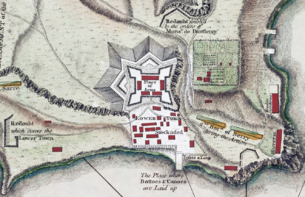 Global Information
Global InformationFort Ticonderoga information
Fort Ticonderoga | |
U.S. National Register of Historic Places | |
U.S. National Historic Landmark | |
Fort Ticonderoga from Mount Defiance | |
   | |
| Location | Ticonderoga, New York |
|---|---|
| Nearest city | Burlington, Vermont |
| Coordinates | 43°50′30″N 73°23′15″W / 43.84167°N 73.38750°W |
| Area | 21,950 acres (34.3 sq mi; 88.8 km2) |
| Built | 1755–1758 |
| Architect | Marquis de Lotbinière |
| Architectural style | Vauban-style fortress |
| NRHP reference No. | 66000519 |
| Significant dates | |
| Added to NRHP | October 15, 1966[1] |
| Designated NHL | October 9, 1960[2] |

Fort Ticonderoga (/taɪkɒndəˈroʊɡə/), formerly Fort Carillon, is a large 18th-century star fort built by the French at a narrows near the south end of Lake Champlain, in northern New York, in the United States. It was constructed by Canadian-born French military engineer Michel Chartier de Lotbinière, Marquis de Lotbinière between October 1755 and 1757, during the action in the "North American theater" of the Seven Years' War, often referred to in the US as the French and Indian War. The fort was of strategic importance during the 18th-century colonial conflicts between Great Britain and France, and again played an important role during the Revolutionary War.
The site controlled a river portage alongside the mouth of the rapids-infested La Chute River, in the 3.5 miles (5.6 km) between Lake Champlain and Lake George. It was thus strategically placed for the competition over trade routes between the British-controlled Hudson River Valley and the French-controlled Saint Lawrence River Valley.
The terrain amplified the importance of the site. Both lakes were long and narrow and oriented north–south, as were the many ridge lines of the Appalachian Mountains, which extended as far south as Georgia. The mountains created nearly impassable terrains to the east and west of the Great Appalachian Valley that the site commanded.
The name "Ticonderoga" comes from the Iroquois word tekontaró:ken, meaning "it is at the junction of two waterways".[3]
During the 1758 Battle of Carillon, 4,000 French defenders were able to repel an attack by 16,000 British troops near the fort. In 1759, the British returned and drove a token French garrison from the fort. During the Revolutionary War, when the British controlled the fort, it was attacked on May 10, 1775, in the Capture of Fort Ticonderoga by the Green Mountain Boys and other state militia under the command of Ethan Allen and Benedict Arnold, who captured it in the surprise attack. Cannons taken from the fort were transported to Boston to lift its siege by the British, who evacuated the city in March 1776. The Americans held the fort until June 1777, when British forces under General John Burgoyne occupied high ground above it; the threat resulted in the Continental Army troops being withdrawn from the fort and its surrounding defenses. The only direct attack on the fort during the Revolution took place in September 1777, when John Brown led 500 Americans in an unsuccessful attempt to capture the fort from about 100 British defenders.
The British abandoned the fort after the failure of the Saratoga campaign, and it ceased to be of military value after 1781. After gaining independence, the United States allowed the fort to fall into ruin; local residents stripped it of much of its usable materials. Purchased by a private family in 1820, it became a stop on tourist routes of the area. Early in the 20th century, its private owners restored the fort. A foundation, the Fort Ticonderoga Association, now operates the fort as a tourist attraction, museum, and research center.
- ^ National Register Information System
- ^ Cite error: The named reference
nhlsumwas invoked but never defined (see the help page). - ^ Afable, p. 193